Creating crime scene 3D model with body wear camera footage
Krzysztof Maksymowicz
Lukasz Szleszkowski
Aleksandra Kuzan
Wojciech Tunikowski
Abstract
The aim of this study is to develop a methodology for creating 3D images of crime scenes based on footage from cameras used by emergency services. To accomplish this, a research experiment was conducted, which consisted of re-enactment of a crime scene and simulation of the actions of the emergency team. The experiment did not illustrate a real case. The scenario was developed and dedicated for the purpose of the research.
The research material of this study consists of footage recorded in digital video format. The footage shows the course of a re-enacted intervention of emergency services at the crime scene. The re-enactment, which was a research experiment, was arranged under conditions close to real ones.
The 3D model of the scene was created in three stages: video analysis and 3D reconstruction of the spatial position of the camera; 3D modelling of the figure of the participant with reconstruction of the position similar to the one in the recording; and 3D scanning of the scene of the simulated crime, assembly of individual elements, and scaling to real dimensions.
The result (a 3D model) was presented in the form of a set of images: horizontal projections, vertical sections, and isometric and perspective views of the model. Technical data of the research equipment as well as other relevant information was presented in tables and diagrams.
This study demonstrated that graphic data obtained unintentionally and through alternative recording sources may significantly complement the data collected in the course of routine medico-legal and forensic activities. The use of cameras during the actions of rescue and emergency services allows us to obtain information of significant importance for medico-legal and forensic analyses. The footage from cameras of emergency services makes it possible to obtain a 3D image of the crime scene for further medico-legal and forensic analyses.
Keywords
3D scanning, 3D animation, reconstruction, image analysis, CCTV
See also the instructional video "Crime Scene Documentation"
Introduction
The initial observers of crime scenes are most often broadly defined as emergency services (mostly the police, fire service, and ambulance). A reconstruction of the sequence of events that took place at such scenes requires acquiring and archiving data describing the space, elements, and participants of these events. Information potentially acquired by intervening officers may have significant implications for medico-legal and forensic analysis of the sequence of events.1,2 At the same time, it should be remembered that the presence of officers at the scene and the actions they undertake may lead to a distortion or even obliteration of relevant information. Therefore, video recording of the course of an intervention is justified.1 The above goal can be accomplished by using field-proven video recording technologies. The special nature of the intervention, the associated required actions, and the often-accompanying situational stress require automatic and unattended video recording. Such technologies have already been put into general practice.3 Examples include static cameras (CCTV cameras, speed camera) and mobile cameras (dashcams, drones) used by both the public sector and individual users.2,4,5 The footage obtained from cameras can be processed and used in medico-legal and forensic analysis of the sequence of events.6 For the purpose of the above analysis, it is important to establish mutual relations and spatial interactions among elements of the scene and its participants. Forensic and medico-legal practice of the authors and other scientific centres proves that digital 3D imaging can be an effective tool for conducting such analyses.7,8
Aim
The aim of this study is to develop a methodology for creating 3D images of crime scenes based on footage from cameras used by emergency services. To accomplish this, a research experiment was conducted, which consisted of re-enactment of a crime scene and simulation of the actions of the emergency team.
Material and methods
The research material of this study consists of footage record ed in digital video format. The footage shows the course of a re-enacted intervention of emergency services at a crime scene. The re-enactment, which was a research experiment, was arranged under conditions close to real ones.
The experiment was performed under the conditions of a simulated intervention and routine actions of paramedics in the scene space. The aim was to minimize the impact of the camera on the officer. This was made possible by deliberate selection of equipment (lightweight, small, with high resolution) and automatic video recording, without requiring the attention and effort of the officer (operator). The camera from the HTC One M8 device was used, with the following parameters: 4MP 1/3-inch CMOS sensor, 2.0 um pixel pitch, F2.0 aperture, 28mm equivalent focal length, HD video 1080p, 30 FPS.
The footage was recorded by digital video cameras mounted on the heads of the officers. In practice, such position of the cameras minimizes the inconvenience of use while providing the maximum possible field of view. The re-enactment scene was the courtyard atrial area of an apartment building, chosen without any preconditions based on the premise that this method should work in all places and conditions. The footage was recorded in daylight and partly in the semi-darkness of the restricted space of a communication tunnel. The ground and other surfaces were wet and semi-reflective after rainfall, representing different colours, textures, and materials. The re-enactment was performed by three role players – two of whom took the part of officers with cameras while the third one was lying on the ground as a possible victim.
The cameras recorded the approach of the officers to the lying role player and the start of rescue activities. In order to objectify the conditions of the experiment and bring them closer to reality, a single recording was made without any reshoots. Figure 1 shows the source material samples.
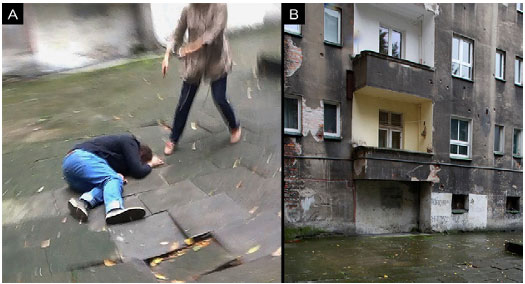
Fig. 1. The source material. A – body wear camera footage, B – environmental photos
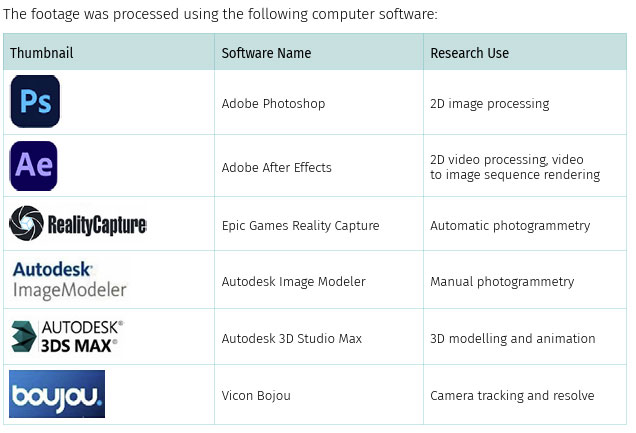
The first step was to increase video quality and render image sequence using Adobe After Effects and Adobe Photoshop software. The next step was the 3D reconstruction of the camera positions. This operation allows observation of the space of a 3D model through the point of view of a virtual camera with the optics and position similar to the real camera. As a result, the created 3D geometric shapes can be modelled and positioned in digital space. Two different methods were chosen for camera position reconstruction. The first method uses the ‘camera tracking’ tool and was performed with a Bojou software. An application algorithm reconstructs the spatial position of the camera and changes in its position in the 3D environment by tracking changes in the position of distinctive image points. The effect of this action is presented in Fig. 2. However, because of low footage quality application process failed, not delivering any usable data in result.
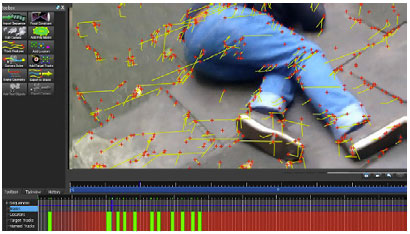
Fig. 2. Camera tracking process. Green blocks indicate successful
processing, red blocks show lack of data in whole movie sequence bar
The second method consisted in converting the footage into individual frames. Because the recording equipment was moving, the recording was accompanied by unwanted image shake that made the footage blurry. The least distorted frames in the sequence were selected (shown as figure 3).
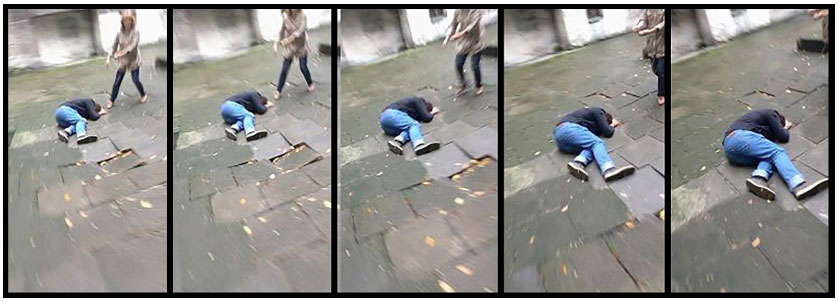
Fig. 3. Converting video to images (frames), choosing most undistorted images, digital sharpening
The set of selected images was processed computationally by Epic Games Reality Capture application algorithm. Its aim is to analyse a series of images of the same space and reconstruct the spatial position of the camera in the 3D environment based on the principles of photogrammetry. Due to the unsatisfactory results of the automatic algorithm of the above application, the frames were also processed in an application with semi-automated tools – Autodesk Image Modeler, where the operator reconstructs the model based on image analysis and manual refinement of calculations (shown as figure 4).
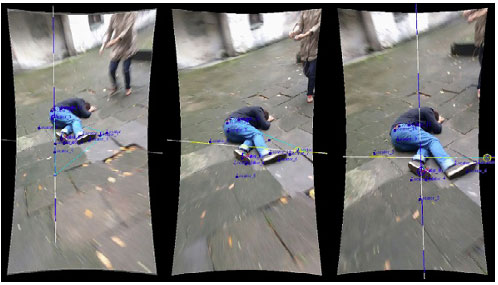
Fig. 4. Manual characteristic points detection to support application process
In the second method, the spatial position of the camera was determined. Automatic application algorithm delivered point cloud information, and manual application allowed view port manual modelling process (shown as figure 5).
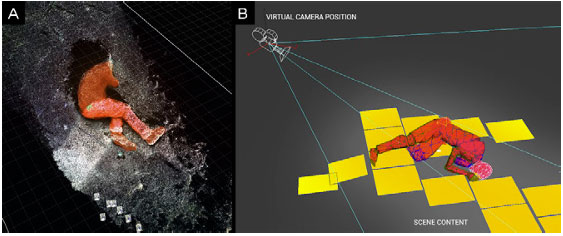
Fig. 5. A – Point cloud from automatic algorithm of Reality Capture,
B – manual model made with manual algorithm of Image Modeler
All the 3D data was imported to Autodesk 3D Studio Max. An animated figure of the role player was created. Next, using virtual camera view with a background integrated image, a fragment of the pavement was recreated (shown as figure 6). Concrete pavement blocks were used as a reference object to find a position and match a scale of body and environment 3D model (created in the next steps).

Fig. 6. Virtual Camera view allows 3D creation of pavement blocks
Next, a 3D model was made of the simulated crime scene. For this purpose, a series of photographs was taken of the surroundings, which was converted to a 3D model using a computer application. The photographs were taken with a still camera following the guidelines in the application manual. A series of control measurements was performed to verify that the obtained scan had correct geometry and was set on the correct scale. The obtained 3D model of the victim was combined with the 3D scan of the environment and resized to the correct full scale. Methodology scheme of the whole reconstruction is shown below.
Results
Results obtained are enumerated below:- The methodology for creating a 3D model of the re-enacted crime scene based on footage from body wear cameras of emergency services (shown as figure 7).
- The 3D model of the re-enacted crime scene based on foot age from body wear cameras of emergency services (shown as figure 8).
- Video presentation of methodology and reconstruction results (shown as figure 9- supplementary material).
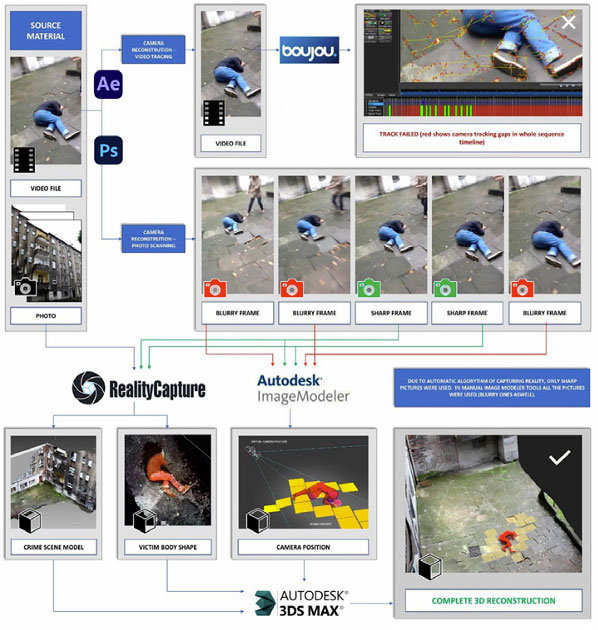
Fig. 7. Methodology scheme
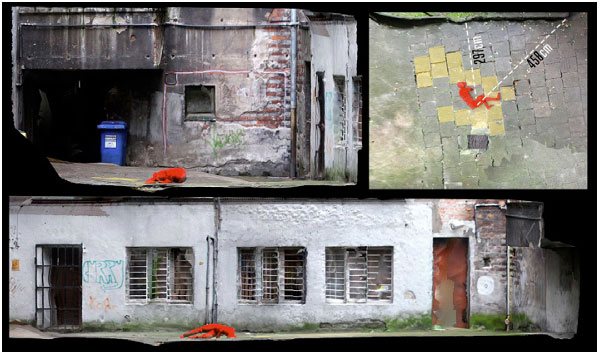
Fig. 8. The 3D model of the re-enacted crime scene based on footage
from body wear cameras of emergency services. A , B – Perspective views, C , D, E – Elevation Views
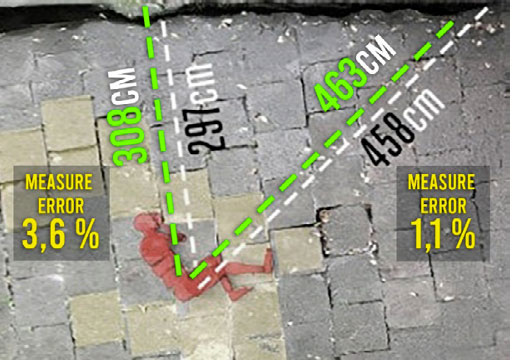
Fig. 9. The reconstruction accuracy depends on source material quality and needs to be examined in every case individually. In the research case study, dimensions from reconstruction were compared to laser disto physical survey. The summary measure error did not exceed 5%. This number is not valid as it can differ in other cases
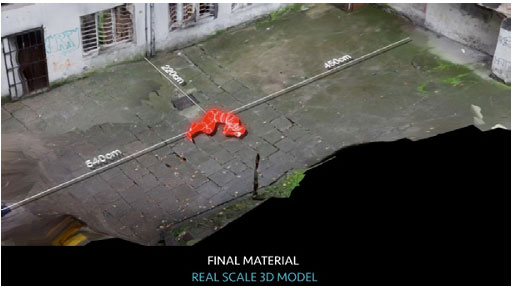
Fig. 10. Video presentation of methodology and reconstruction results
Discussion
Body worn camera has obvious advantages, but could be physically and mentally uncomfortable for the operator1,9,10 Mainly because it is further additional equipment that operator needs to deal with, but also because it is recording operator’s actions in difficult conditions, where some controversial decision can be made and recorded. Intervention is an emergency situation where human life may be – and usually is – in jeopardy. In order to minimize the impact of this study on the course of an actual intervention, the authors decided to conduct research in the mode of a simulated sequence of events.
The priority of the responding officers is to perform the tasks directly related to the intervention, therefore it was necessary to choose the method of video recording that would not require the attention and involvement of the operator and would respect the local law in this matter.5 An analysis of possible conditions of an intervention in the context of the subsequent 3D reconstruction of the sequence of events should take into account several important issues.
Reconstruction is based on selected photogrammetric methods and techniques. Photogrammetry is a collection of techniques for acquiring information about spatial geometry and dimensions as well as spatial imaging in a 3D environment.11 A 3D model of the examined space is obtained from a sequence of 2D images of that space. Those images must differ from one another by the adopted position of their recording (photographs taken from different locations). The recoding and spatial conditions during the recording process should be as stable as possible to increase the accuracy of the 3D model being created.
The officer and, consequently, also the camera are in constant motion. Elements of the space and other participants at the crime scene are in motion as well. The totality of the circumstances of the crime is characterized by high dynamics. There fore, the image is shaking during the recording, which significantly decreases the quality of the footage.12 As the officer moves his head, the field of view of the head-mounted camera changes over time, so the video recording sequences of a particular object are short. This makes photogrammetric reconstruction of the footage more challenging. Changing lighting conditions (e.g. warning lights of an ambulance) also complicate application of photogrammetry in reconstruction.
The conditions of an intervention are difficult and unpredictable, which is why the camera should be versatile and non-in terfering with the course of the intervention. Therefore, for practical reasons it should be small and lightweight. In general, the recording equipment with such parameters is characterized by low versatility and the quality of the recorded footage is low.
To improve the accuracy of the 3D reconstruction, at least two different methods should be used and the results obtained should be correlated. Just one measurement of the physical space is required to reconstruct the model scale. On the other hand, two additional dimensions of the physical space must be obtained to verify the geometric correctness of the model.
The footage from cameras of emergency services was used to obtain a 3D image of the re-enacted crime scene. The 3D model is presented as a set of drawings and video sequences. The drawings are horizontal projections, vertical sections, and isometric and perspective views of the model, and could be presented in numerous other ways.13
The results of the research experiment have shown the potential usefulness of the proposed methods of video recording of the crime.14
Traditional ways of obtaining data about the scene and sequence of events have their limitations. The main one is image capture or drawing up a description after a significant time has passed since the crime. Significant traces (information) may be lost due to the course of the intervention and other factors not directly related to the intervention (atmospheric phenomena, accidental users of the space, and natural destruction). The above applies to the traces resulting from the intervention itself and those that appeared later on. It is, therefore, justifiable to seek methods that would minimize this problem.
The methods proposed in this study allow us to obtain an image of the course of intervention that is as close as possible to the actual image of the space at the time of the crime. In addition, these methods enable archiving of unpredictable and non-standard elements of the crime scene and the details relevant to the case.15 They can also incidentally archive objects and processes taking place in the space that could be omitted using other methods of documentation. The randomness of the recorded data can lead to the acquisition of material that is more valuable than the material intention ally accumulated in the case.16
The results of the research experiment have demonstrated the potential usefulness of the proposed methods of recording the image of the crime scene space and its 3D reconstruction. Owing to their indisputable advantages, the methods proposed by the authors can provide a valuable complement to the traditional methods.17,18 However, due to their short comings, they cannot constitute an independent recording method. Traditional methods and the methods proposed in this study should be viewed as complementary rather than alternative approaches.
Conclusions
The graphic data obtained unintentionally by rescue and emergency services and through alternative recording sources may significantly complement the data collected in the course of routine medico-legal and forensic activities. Unfortunately, the graphic data obtained unintentionally and under specific circumstances may be characterized by insufficient technical quality. Therefore, its processing and analysis requires appropriate elaboration and appropriate critical judgment.
The footage from cameras of emergency services makes it possible to obtain a 3D image of the crime scene for further medico-legal and forensic analyses. Further research and consideration should focus on assessment of the application of cameras under circumstances similar to the executed studies, made by officers of emergency services. It should be emphasized that both traditional methods of acquiring data about the crime scene and the methods proposed in this study should be viewed as complementary rather than alternative approaches.
References
- Coudert F, Butin D, Le Métayer D. Body-worn cameras for police accountability: Opportunities and risks. Comput Law Secur Rev Int J Technol Law Pract. 2015;31:749-762. doi:10.1016/j.clsr.2015.09.002
- Bowling B, Iyer S. Automated policing: the case of body-worn video. Int J Law Context. 2019;15(2):140-161. doi:10.1017/S1744552319000089
- Korva N, Bennell C, Lalumière ML, Karimullah M. What do you see? Understanding perceptions of police use of force videos as a function of the camera perspective. Behav Sci Law. 2022;40(3):480-503. doi:10.1002/BSL.2578
- Urbanová P, Jurda M, Vojtíšek T, Krajsa J. Using drone-mounted cameras for on-site body documentation: 3D mapping and active survey. Forensic Sci Int. 2017;281:52-62. doi:10.1016/J.FORSCIINT.2017.10.027
- Turner BL, Caruso EM, Dilich MA, Roese NJ. Body camera footage leads to lower judgments of intent than dash camera footage. Proc Natl Acad Sci U S A. 2019;116(4):1201-1206. doi:10.1073/PNAS.1805928116
- Edelman G, Bijhold J. Tracking people and cars using 3D modeling and CCTV. Forensic Sci Int. 2010;202(1-3):26-35. doi:10.1016/J.FORSCI INT.2010.04.021
- Buck U, Naether S, Räss B, Jackowski C, Thali MJ. Accident or homicide--virtual crime scene reconstruction using 3D methods. Forensic Sci Int. 2013;225(1-3):75-84. doi:10.1016/J.FORSCIINT.2012.05.015
- Buck U, Naether S, Braun M, et al. Application of 3D documentation and geometric reconstruction methods in traffic accident analysis: with high resolution surface scanning, radiological MSCT/MRI scanning and real data based animation. Forensic Sci Int. 2007;170(1):20-28. doi:10.1016/J.FORSCIINT.2006.08.024
- Hughes TW, Campbell BA, Schaefer BP. The influence of body-worn cameras, minority threat, and place on police activity. J Community Psychol. 2020;48(1):68-85. doi:10.1002/JCOP.22299
- Boivin R, Faubert C, Gendron A, Poulin B. Explaining the Body-Worn Camera Perspective Bias. J Qual Crim Justice Criminol. 2020;9(1). doi:10.21428/88DE04A1.BC4FDEDA
- Flies MJ, Larsen PK, Lynnerup N, Villa C. Forensic 3D documentation of skin injuries using photogrammetry: photographs vs video and manual vs automatic measurements. Int J Legal Med. 2019;133(3):963-971. doi:10.1007/S00414-018-1982-6/FIGURES/5
- Guilluy W, Oudre L, Beghdadi A. Video stabilization: Overview, challenges and perspectives. Signal Process Image Commun. 2021;90:116015. doi:10.1016/J.IMAGE.2020.116015
- Ma M, Zheng H, Lallie H. Virtual reality and 3D animation in forensic visualization. J Forensic Sci. 2010;55(5):1227-1231. doi:10.1111/J.1556-4029.2010.01453.X
- Milliet Q, Delémont O, Margot P. A forensic science perspective on the role of images in crime investigation and reconstruction. Sci Justice. 2014;54(6):470-480. doi:10.1016/J.SCIJUS.2014.07.001
- Adamczyk M, Sienilo M, Sitnik R, Wozniak A. Hierarchical, Three-Dimensional Measurement System for Crime Scene Scanning. J Forensic Sci. 2017;62(4):889-899. doi:10.1111/1556-4029.13382
- Maksymowicz K, Tunikowski W, Kosciuk J. Crime event 3D reconstruction based on incomplete or fragmentary evidence material--case report. Forensic Sci Int. 2014;242:e6-e11. doi:10.1016/J.FORSCIINT.2014.07.004
- Schofield D, Fowle K. Number 1 Article 4 2013 Part of the Computer Engineering Commons. J Digit Forensics, Secur Law. 2013;8(1). doi:10.15394/jdfsl.2013.1141
- Gotsmy WF, Ebert LC, Bolliger M, et al. A picture is worth a thousand words--the utility of 3D visualization illustrated by a case of survived pancreatic transection. Leg Med (Tokyo). 2011;13(2):95-97. doi:10.1016/J.LEGALMED.2010.11.006
About the Authors
Krzysztof Maksymowicz- 3D Analysis Laboratory Department of Forensic Medicine of Wroclaw Medical University, Poland
- Department of Forensic Medicine of Wroclaw Medical University, Poland
- Department of Medical Biochemistry, Wroclaw Medical University, 50-368 Wroclaw, Poland
- 3D Analysis Laboratory Department of Forensic Medicine of Wroclaw Medical University, Poland
- Faculty of Architecture, Wroclaw University of Science and Technology, Poland
 Creating crime scene 3D model with body wear camera footage Copyright: © 2023 by Krzysztof Maksymowicz, Lukasz Szleszkowski, Aleksandra Kuzan, and Wojciech Tunikowski. Copyright for this article is retained by the authors. This is an Open Access article distributed under the terms of the Creative Commons Attribution-NonCommercial-NoDerivatives 4.0 International License which permits unrestricted noncommercial use, distribution, and reproduction, provided the original work is properly cited and not changed in any way. Based on a work at http://www.crime-scene-investigator.net/creating-crime-scene-3d-model-with-body-wear-camera-footage.html.
Creating crime scene 3D model with body wear camera footage Copyright: © 2023 by Krzysztof Maksymowicz, Lukasz Szleszkowski, Aleksandra Kuzan, and Wojciech Tunikowski. Copyright for this article is retained by the authors. This is an Open Access article distributed under the terms of the Creative Commons Attribution-NonCommercial-NoDerivatives 4.0 International License which permits unrestricted noncommercial use, distribution, and reproduction, provided the original work is properly cited and not changed in any way. Based on a work at http://www.crime-scene-investigator.net/creating-crime-scene-3d-model-with-body-wear-camera-footage.html.
Article posted March 22, 2024

